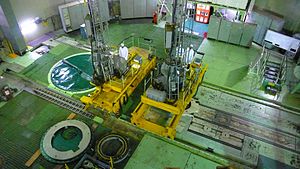| Madras Atomic Power station | |
|---|---|
 | |
 | |
| Country | India |
| Coordinates | 12°33′27″N 80°10′30″E / 12.55750°N 80.17500°E |
| Status | Operational |
| Construction began | Units 1 & 2: 1970 PFBR: January 2004 |
| Commission date | Units 1: 27 January 1984 Units 2: 21 March 1986 |
| Owner(s) | Units 1 & 2: NPCIL PFBR, FBR-1&2: BHAVINI |
| Operator(s) | Units 1 & 2: NPCIL PFBR, FBR-1&2: BHAVINI |
| Nuclear power station | |
| Reactors | 2 |
| Reactor type | Units 1 & 2: IPHWR-220 PFBR: Prototype FBR-1&2: FBR-600 |
| Reactor supplier | Units 1 & 2: BARC/NPCIL PFBR, FBR-1&2: IGCAR/BHAVINI |
| Cooling source | Bay of Bengal |
| Power generation | |
| Units operational | 2 × 220 MW |
| Units planned | 2 × 600 MW |
| Units under const. | 1 × 500 MW |
| Nameplate capacity | 410 MW |
| Capacity factor | 44.21% (2020-21)[1] |
| Annual net output | 1703.92 GW.h (2020-21)[1] |
| External links | |
| Website | Nuclear power Corporation of India Ltd |
| Commons | Related media on Commons |
Madras Atomic Power Station (MAPS) located at Kalpakkam about 80 kilometres (50 mi) south of Chennai, India, is a comprehensive nuclear power production, fuel reprocessing, and waste treatment facility that includes plutonium fuel fabrication for fast breeder reactors (FBRs). It is also India's first fully indigenously constructed nuclear power station, with two units each generating 220 MW of electricity. The first and second units of the station went critical in 1983 and 1985, respectively. The station has reactors housed in a reactor building with double shell containment improving protection also in the case of a loss-of-coolant accident. An Interim Storage Facility (ISF) is also located in Kalpakkam.
The facility is also home to India's first large scale fast breeder reactor of 500 MWe called the Prototype Fast Breeder Reactor operated by BHAVINI and will also be the site of first two FBR-600 commercial fast breeder reactors.[2]
- ^ a b "Monthly Genration Reports Actual for Apr – 2021 : Central Sector Nuclear" (PDF). National Power Portal. Central Electricity Authority. Retrieved 10 October 2021.
- ^ Chetal, SC (January 2013). "Beyond PFBR to FBR 1 and 2" (PDF). IGC Newsletter. 95. Indira Gandhi Centre for Atomic Research: 2. Retrieved 16 April 2021.